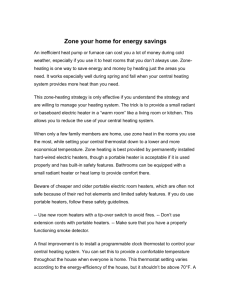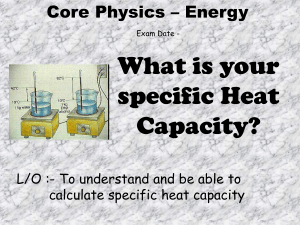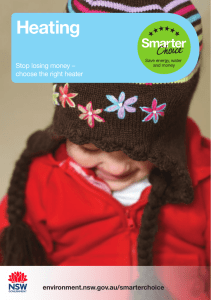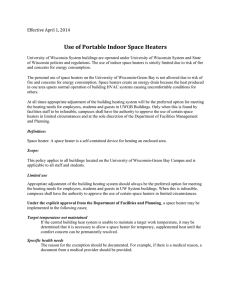Space Heater Use Program
advertisement
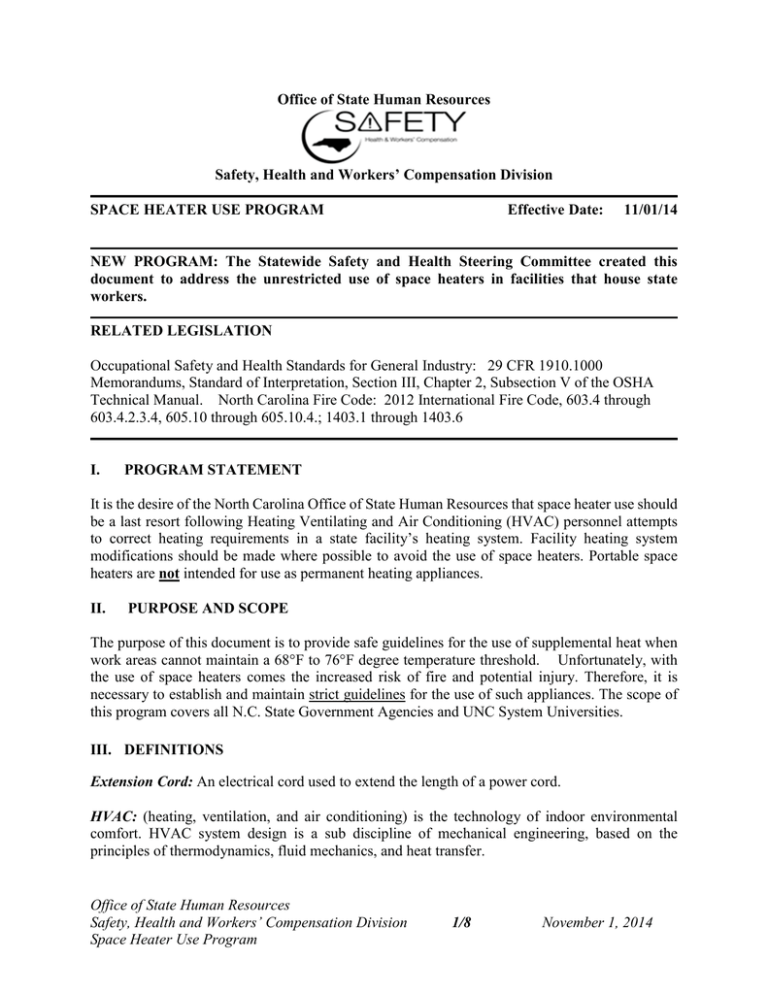
Office of State Human Resources Safety, Health and Workers’ Compensation Division SPACE HEATER USE PROGRAM Effective Date: 11/01/14 NEW PROGRAM: The Statewide Safety and Health Steering Committee created this document to address the unrestricted use of space heaters in facilities that house state workers. RELATED LEGISLATION Occupational Safety and Health Standards for General Industry: 29 CFR 1910.1000 Memorandums, Standard of Interpretation, Section III, Chapter 2, Subsection V of the OSHA Technical Manual. North Carolina Fire Code: 2012 International Fire Code, 603.4 through 603.4.2.3.4, 605.10 through 605.10.4.; 1403.1 through 1403.6 I. PROGRAM STATEMENT It is the desire of the North Carolina Office of State Human Resources that space heater use should be a last resort following Heating Ventilating and Air Conditioning (HVAC) personnel attempts to correct heating requirements in a state facility’s heating system. Facility heating system modifications should be made where possible to avoid the use of space heaters. Portable space heaters are not intended for use as permanent heating appliances. II. PURPOSE AND SCOPE The purpose of this document is to provide safe guidelines for the use of supplemental heat when work areas cannot maintain a 68°F to 76°F degree temperature threshold. Unfortunately, with the use of space heaters comes the increased risk of fire and potential injury. Therefore, it is necessary to establish and maintain strict guidelines for the use of such appliances. The scope of this program covers all N.C. State Government Agencies and UNC System Universities. III. DEFINITIONS Extension Cord: An electrical cord used to extend the length of a power cord. HVAC: (heating, ventilation, and air conditioning) is the technology of indoor environmental comfort. HVAC system design is a sub discipline of mechanical engineering, based on the principles of thermodynamics, fluid mechanics, and heat transfer. Office of State Human Resources Safety, Health and Workers’ Compensation Division Space Heater Use Program 1/8 November 1, 2014 Multi-outlet strip: An AC power outlet with numerous receptacles. Space Heater: An appliance that warms a small area, such as one room, typically by radiant electric or fuel-fired heat. (For the purpose of the Space Heater Use Program, this also includes items such as but not limited to electric blankets, pads, “foot warmers” and similar products that produce heat from an electrical or fuel source.) Surge Protector: An appliance designed to protect electrical devices from voltage spikes. A surge protector attempts to limit the voltage supplied to an electric device by either blocking or by shorting to ground any unwanted voltages above a safe threshold. UL Listing: Underwriters Laboratories provided safety-related certification, validation, testing, inspection, auditing, advising and training services to a wide range of clients, including manufacturers, retailers, policymakers, regulators, service companies, and consumers. Group A: Assembly Occupancies: A building, structure or portion thereof, for the gathering of persons for purposes such as civic, social, or religious functions; food or drink consumption; or awaiting transportation. Group E: Educational Occupancies: A building, structure or portion thereof, used by six or more persons at any one time for educational purposes through the 12th grade; and for educational, supervision or personal care services for more than five children older than 2.5 years of age. Group F: Factory Industrial Group F occupancy includes, among others, the use of a building or structure, or portion thereof, for assembling, disassembling, fabricating, finishing, manufacturing, packaging, repair or processing operations that are not classified as a Group H high-hazard or Group S storage occupancy Group H: High-hazard Group H occupancy includes, among others, the use of a building or structure, or a portion thereof, that involves the manufacturing, processing, generation or storage of materials that constitute a physical or health hazard in quantities in excess of those allowed in controlled areas complying with Section 2703.8.3, based on maximum allowable quantity limits for control areas set forth in tables 2703.1.1(1) and 2703.1.1(2). Group I: Institutional Occupancies: A building or structure or portion thereof, in which people are cared for or live in a supervised environment, having physical limitations because of health or age, are harbored for medical treatment of other care or treatment, or in which people are detained for penal or correctional purposes or in which the liberty of the occupants is restricted. Institutional occupancies shall be classified as Group I-1, I-2, I-3 or I-4. Group M: Mercantile Group M occupancy includes, among others, the use of a building or structure or portion thereof, for the display and sale of merchandise and involves stocks of goods, wares or merchandise incidental to such purpose and accessible to the public. Group R-1: Residential occupancies containing sleeping units where the occupants are primarily transient in nature. Office of State Human Resources Safety, Health and Workers’ Compensation Division Space Heater Use Program 2/8 November 1, 2014 Group R-2: Residential occupancies containing sleeping units or more than two dwelling units where the occupants are primarily permanent in nature. Group R-3: Residential occupancies where the occupants are primarily permanent in nature and are not classified as Groups R-1, R-2, R-4, or I, including: Adult care facilities for five or fewer persons for less than 24 hours. Child care facilities for eight or fewer persons, with no more than five preschool, for less than 24 hours. Group R-4: Residential occupancies shall include buildings arranged for occupancy as residential care/assisted living facilities, or adult and child day care facilities that provide accommodations in a residence occupied as a home by the caregiver for persons of any age for less than 24 hours, including more than five but not more than sixteen occupants, excluding staff. Group S: Storage Group S occupancy includes, among others, the use of a building or structure, or a portion thereof, for storage that is not classified as a hazardous occupancy. IV. EMPLOYEE RESPONSIBILITY 1. When it is impossible to maintain a suitable working environment (68°F-76ºF), as documented by the HVAC personnel or other qualified person, a space heater can be utilized based on the requirements of this program. The employee seeking to use a space heater must initiate the space heater permit form (See Appendix B) and abide by the following guidelines. 2. For medical conditions requiring supplemental space heating in an otherwise suitable working environment (68°F-76ºF), proper medical documentation from a Licensed Practicing Physician and recommendation for supplemental heat is required prior to approval of space heater use. (See Appendix B) 3. The user of the space heater must follow all manufacturers’ operating instructions and requirements. 4. Electrical circuits shall not be overloaded. Do not reset any tripped breakers. Overloaded circuits present a fire hazard. Call Facilities Services for tripped breaker resets. 5. The space heater must contain fully enclosed heating surfaces, be provided with a thermostat, tip over safety shut off, and be listed by an approved listing agency such as Underwriter Laboratories or other accredited listing agent. 6. The user must ensure the space heater is not plugged into an extension cord, multioutlet strip, or surge protector. The space heater must plug directly into an approved 120 volt AC receptacle. Space heaters and their cords shall not be positioned so as to create a tripping hazard in the work area. Office of State Human Resources Safety, Health and Workers’ Compensation Division Space Heater Use Program 3/8 November 1, 2014 V. 7. The employee will ensure that the space heater is turned off when unattended and at the close of business. 8. A minimum three feet area around, in front of, and above the space heater or an area greater as recommended by the manufacturer will be maintained around the space heater as clearance from combustibles. Space heaters shall not be used under desk or other furniture or equipment unless the aforementioned space requirements shall be met. 9. Portable electric space heaters shall not have worn or damaged electrical cords, and the plugs shall be in good condition. 10. Fuel fired space heaters shall be for Non-Office Use Only i.e. garages, warehouses, storage. (See Appendix A) 11. Fuel fired space heaters shall be free of any and all leaks. EMPLOYER RESPONSIBILITY 1. Contact the facility HVAC Department to correct heating requirements by the central HVAC system. 2. Install weather stripping or control other sources of cold air and/or drafts. 3. Provide documentation that any and all corrective actions have been taken to maintain a suitable working environment (68°F-76ºF) in the affected work area. 4. Division Director or Designee (Designee must manage the local facility) will ensure this program is followed across the agency. 5. Program Evaluation will be conducted to assure compliance. 6. Space Heaters shall be inspected annually and the need for their continued use reevaluated. VI. TRAINING: Employees shall review and comply with this program. VII. DOCUMENT HISTORY: 10/8/2014 New Program 11/1/2014 Revision 1: Added Group I to 603.4 Fire Code Office of State Human Resources Safety, Health and Workers’ Compensation Division Space Heater Use Program 4/8 November 1, 2014 Appendix A N.C. Fire Prevention Code, 2012 Edition, Chapter 6: Building Services and System, Section 603 Fuel-Fired Appliances 603.4 Portable unvented heaters. Portable unvented fuel-fired heating equipment shall be prohibited in occupancies in Groups A, E, I, R-1, R-2, R-3 and R-4. Exceptions: Listed and approved unvented fuel-fired heaters, including portable outdoor gas-fired heating appliances, in one- and two-family dwellings. Portable outdoor gas-fired heating appliances shall be allowed in accordance with Section 603.4.2. 603.4.1 Prohibited locations. Unvented fuel-fired heating equipment shall not be located in, or obtain combustion air from, any of the following rooms or spaces: sleeping rooms, bathrooms, toilet rooms or storage closets. 603.4.2 Portable outdoor gas-fired heating appliances. Portable gas-fired heating appliances located outdoors shall be in accordance with Sections 603.4.2.1 through 603.4.2.3.4. 603.4.2.1 Location. Portable outdoor gas-fired heating appliances shall be located in accordance with Sections 603.4.2.1.1 through 603.4.2.1.4. 603.4.2.1.1 Prohibited locations. The storage or use of portable outdoor gas-fired heating appliances is prohibited in any of the following locations: a. b. c. Inside of any occupancy when connected to the fuel gas container. Inside of tents, canopies and membrane structures. On exterior balconies. Exception: As allowed in Section 6.17 of NFPA 58. Note: Contact your local fire marshal or the Department of Insurance prior to implementing exceptions. 603.4.2.1.2 Clearance to buildings. Portable outdoor gas-fired heating appliances shall be located at least 5 feet (1524 mm) from buildings. 603.4.2.1.3 Clearance to combustible materials. Portable outdoor gas-fired heating appliances shall not be located beneath, or closer than 5 feet (1524 mm) to combustible decorations and combustible overhangs, awnings, sunshades or similar combustible attachments to buildings. Office of State Human Resources Safety, Health and Workers’ Compensation Division Space Heater Use Program 5/8 November 1, 2014 603.4.2.1.4 Proximity to exits. Portable outdoor gas-fired heating appliances shall not be located within 5 feet (1524 mm) of exits or exit discharges. 603.4.2.2 Installation and operation. Portable outdoor gas-fired heating appliances shall be installed and operated in accordance with Sections 603.4.2.2.1 through 603.4.2.2.4. 603.4.2.2.1 Listing and approval. Only listed and approved portable outdoor gas-fired heating appliances utilizing a fuel gas container that is integral to the appliance shall be used. 603.4.2.2.2 Installation and maintenance. Portable outdoor gas-fired heating appliances shall be installed and maintained in accordance with the manufacturer’s instructions. 603.4.2.2.3 Tip-over switch. Portable outdoor gas-fired heating appliances shall be equipped with a tilt or tip-over switch that automatically shuts off the flow of gas if the appliance is tilted more than 15 degrees (0.26 rad) from the vertical. 603.4.2.2.4 Guard against contact. The heating element or combustion chamber of portable outdoor gas-fired heating appliances shall be permanently guarded so as to prevent accidental contact by persons or material. 603.4.2.3 Gas containers. Fuel gas containers for portable outdoor gas-fired heating appliances shall comply with Sections 603.4.2.3.1 through 603.4.2.3.4. 603.4.2.3.1 Approved containers. Only approved DOTn or ASME gas containers shall be used. 603.4.2.3.2 Container replacement. Replacement of fuel gas containers in portable outdoor gasfired heating appliances shall not be conducted while the public is present. 603.4.2.3.3 Container capacity. The maximum individual capacity of gas containers used in connection with portable outdoor gas-fired heating appliances shall not exceed 20 pounds (9 kg). 603.4.2.3.4 Indoor storage prohibited. Gas containers shall not be stored inside of buildings except in accordance with Chapter 38. Section 605 Electrical Equipment, Wiring and Hazards 605.10 Portable, electric space heaters. Where not prohibited by other sections of this code, portable, electric space heaters shall be permitted to be used in all occupancies other than Group I-2 and in accordance with Sections 605.10.1 through 605.10.4. Exception: The use of portable, electric space heaters in which the heating element cannot exceed a temperature of 212°F (100°C) shall be permitted in nonsleeping staff and employee areas in Group I-2 occupancies. 605.10.1 Listed and labeled. Only listed and labeled portable, electric space heaters shall be used. Office of State Human Resources Safety, Health and Workers’ Compensation Division 6/8 November 1, 2014 Space Heater Use Program 605.10.2 Power supply. Portable, electric space heaters shall be plugged directly into an approved receptacle. 605.10.3 Extension cords. Portable, electric space heaters shall not be plugged into extension cords. 605.10.4 Prohibited areas. Portable, electric space heaters shall not be operated within 3 feet (914 mm) of any combustible materials. Portable, electric space heaters shall be operated only in locations for which they are listed. N.C. Fire Prevention Code, 2012 Edition, Chapter 14: Fire Safety During Construction and Demolition, Section 1403 Temporary Heating Equipment 1403.1 Listed. Temporary heating devices shall be listed and labeled in accordance with the International Mechanical Code or the International Fuel Gas Code. Installation, maintenance and use of temporary heating devices shall be in accordance with the terms of the listing. 1403.2 Oil-fired heaters. Oil-fired heaters shall comply with Section 603. 1403.3 LP-gas heaters. Fuel supplies for liquefied-petroleum gas-fired heaters shall comply with Chapter 38 and the International Fuel Gas Code. 1403.4 Refueling. Refueling operations for liquid-fueled equipment or appliances shall be conducted in accordance with Section 3405. The equipment or appliance shall be allowed to cool prior to refueling. 1403.5 Installation. Clearance to combustibles from temporary heating devices shall be maintained in accordance with the labeled equipment. When in operation, temporary heating devices shall be fixed in place and protected from damage, dislodgement or overturning in accordance with manufacturer’s instructions. 1403.6 Supervision. The use of temporary heating devices shall be supervised and maintained only by competent personnel. Office of State Human Resources Safety, Health and Workers’ Compensation Division Space Heater Use Program 7/8 November 1, 2014 Appendix B North Carolina State Government Space Heater Use Permit and/or Annual Medical Authorization Form Facility/Campus Name ______________________________Date of Request________________ Applicant’s Name _______________________________________________________________ Applicant’s Email Address ________________________________________________________ Room Number __________________ Appliance Type & Size _____________________________ Appliance Model Number_________________________________________________________ Applicant Signature _____________________________________________________________ Supervisor’s Signature ___________________________________________________________ Safety Representative Signature____________________________________________________ Facility Maintenance or Electrical Representative verifying circuits will handle the appliance and auto shut off device is operating. Maintenance Representative______________________________________________________ Medical Authorization Section (For Medically Required uses, Annual Review Required) This permit section is not valid unless it is fully completed and signed by a licensed healthcare provider. I confer that the employee has a medical condition and requires additional heating. By signing this document, I conclude that the addition of heating is not a preference but due to a medical condition outside the control of the employee. The employer is responsible for purchasing the heating device and following the requirements of this program. Dr’s Practice and Address_________________________________________________________ Dr’s Name Printed_______________________________________________________________ Dr’s Signature__________________________________________________________________ Office of State Human Resources Safety, Health and Workers’ Compensation Division Space Heater Use Program 8/8 November 1, 2014
